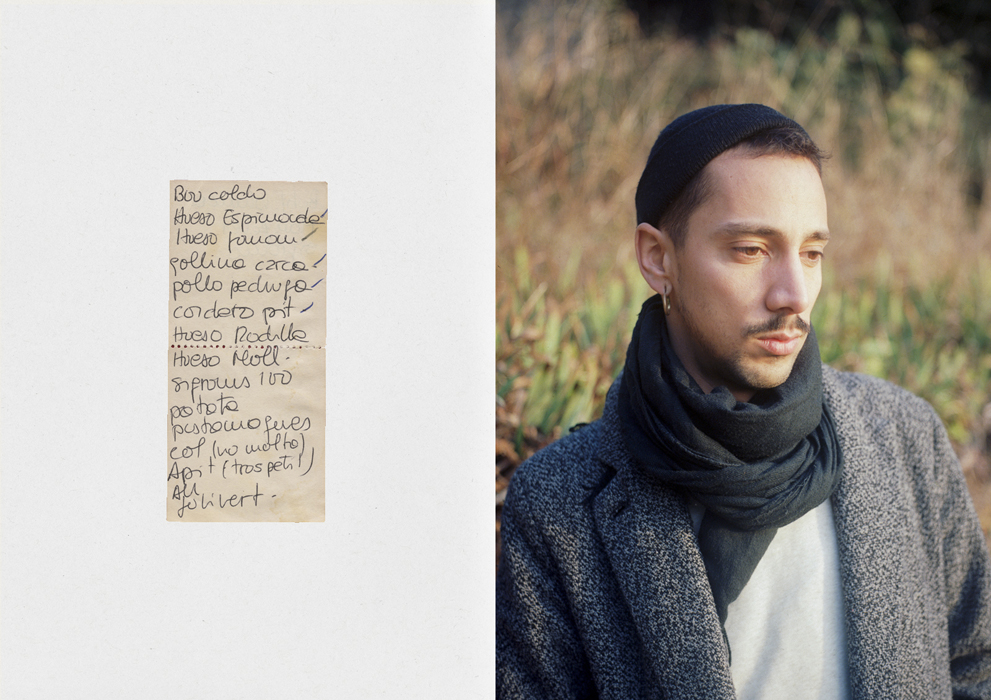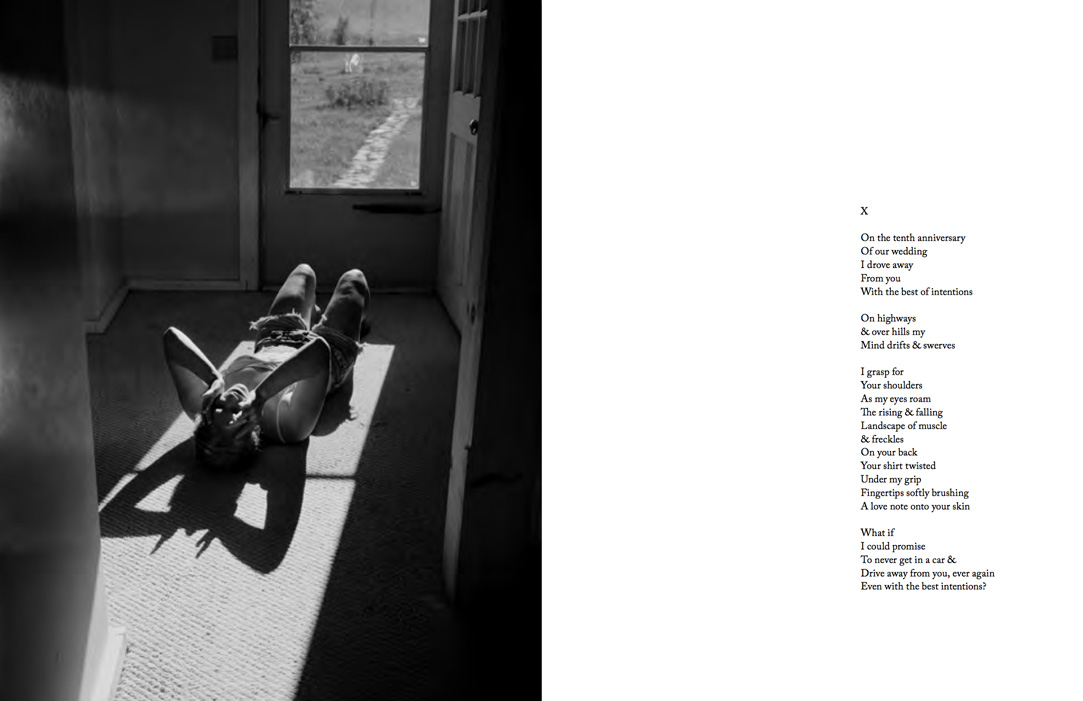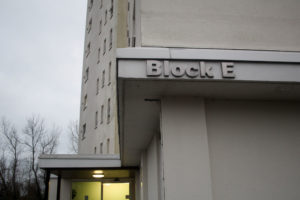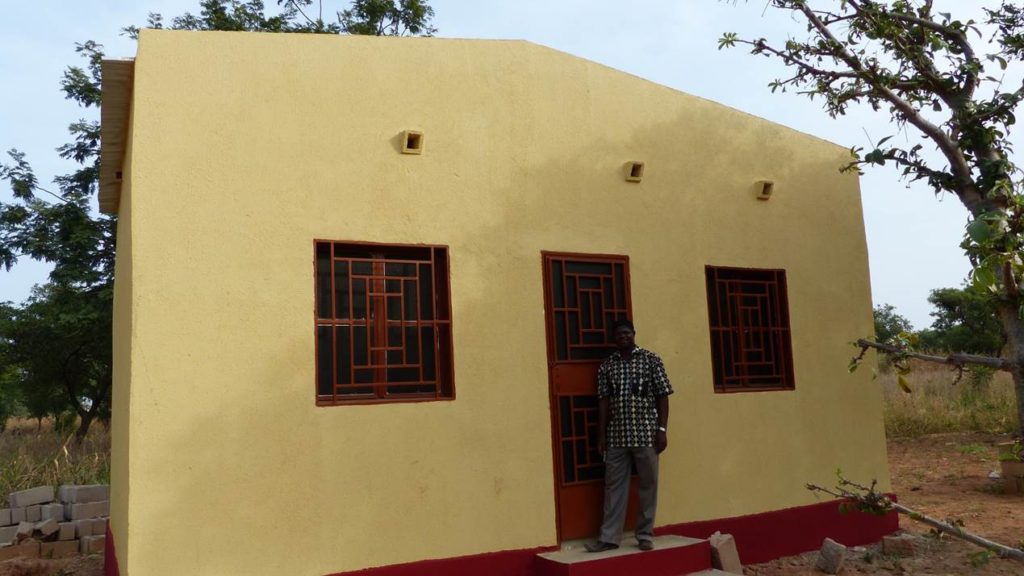Below are all my inspirations I have taken for my ongoing project based around the theme of relationship within my life and how the prominent event being my mum and dad’s divorce when I was 4 years old has shaped my life.
The artists and their projects shown below have attracted me and encouraged me to take inspiration from them because the images themselves are very poetic and conceptual and I they follow a style of imagery I wish to create. As well, the contexts of some of the images from the artists projects relate to that of my own – for example, Alec Soth’s project ‘Looking For Love’ looks at the search for love through the eye and the heart. All of the images below, in some way, encapsulate the idea of relationships and attachment or detachment love causes – Yoshikatsu Fujii’s project ‘Red String’ looks at his mother and fathers divorce and tells a narrative from two perspectives. As well, projects like ‘Josephine’ and ‘The Notion of Family’ looks at relationships between family members and how cohesive or damaging this may be.
I will also be using the research constructed from this task to help me produce the starting points for my personal study. From the research carried out on the artists below, I will be able to use this to generate more observations on their work, in particular , two artists of my choice rot help me begin my study inn which I will have to choose a question to answer based on the comparison of two photographers. I will most likely choose Matt Eich and Yohsikatsu Fujii or Matt Eich and LaToya Ruby Frazier.
Matt Eich - 'I Love You, I'm Leaving'
(website)
“I Love You, I’m Leaving is my meditation on familial bonds, longing, and memory. The series borrows from personal experience and the visual language of the everyday in order to create a fictional account that mirrors my reality. Made during a time of personal domestic unease, I photographed as my parents separated, and my family moved to a new city.”
– Matt Eich
When I first encountered this project by Matt Eich which encapsulates the difficult and uneasing event of his parents after 33 years of marriage, separating and whilst this is occurring, he captures the process of his own family moving into a new city and leaving his parents suffer the grief of a separation lonesomely. The images themselves attracted me due to their pure poetic nature., They are very delicate and speak through the composition and framing of each subject. Every image is set-up perfectly and presented in such a way that a story as well as emotions can easily be derived from the visuals included in the project.
Each image is taken in black and white and this is something that although can be quite difficult due to the heavy focus on lighting, tones and shadows to create atmosphere and mood, Eich has pulled off very well and the primary focus on greys and neutral tones over the heavy contrasts makes for very visually stunning images. They look as if they have a glow and they look very heavily in a way that we can understand the relationships Eich wants to show and how in the most of his parents’ divorce, he can find a sense of happiness and togetherness in his own family bonds of his wife and kids as they begin a new life in a new location.
Eich plays with close-ups of still life and nature to provide a different view from the portraits and candid moments he captures of life ta home with his family. Below is an image of, what looks like his wife, cutting his hair in the garden as his children play and pose for the camera. The side profiles of both Eich and his wife play very important roles in showing their important within this family circle. In opposition to this, from the children’s role in the image, we can see that they are playful and are looking to have fun on this summer’s day as they find ways to interact with the camera in between their moments of play. Furthermore, the image is very well composed and framed,m like I said. All the family is included in the mage, amazing it very difficult to capture but Eich has created a perfect image to lead the audiences eyes through each subject one by one as a curve from the heights of each subject is framed from the bottom left corner of the image to the far right of the image.
Without using Eich an inspiration, I create a very similar image in my photoshoot completed with my mum and girlfriend in which my girlfriend is cutting my mum’s hair. It was a few weeks ago that I did this as my girlfriend was asked by my mum to cut her hair as she is a training hairdresser and I thought this would perfect to show my own familial bonds and relationship as well as cohesion in my fmaily. The images I will be using from this shoot is an image I created using a reflection of a glass door and the aftermath of my mum’s hair being cut – a partly blurred image of the hair on the kitchen door. This rpresnsts the idea of a detachment from something you have created an attachment with. My mum has lost her hair and can be seen as a metaphor for losing something more real and much more influential on her life – the divorce. It is, in a way, showing the removal of an identity that my mum has built over many years as she has grown her hair but at some point, has to lose.
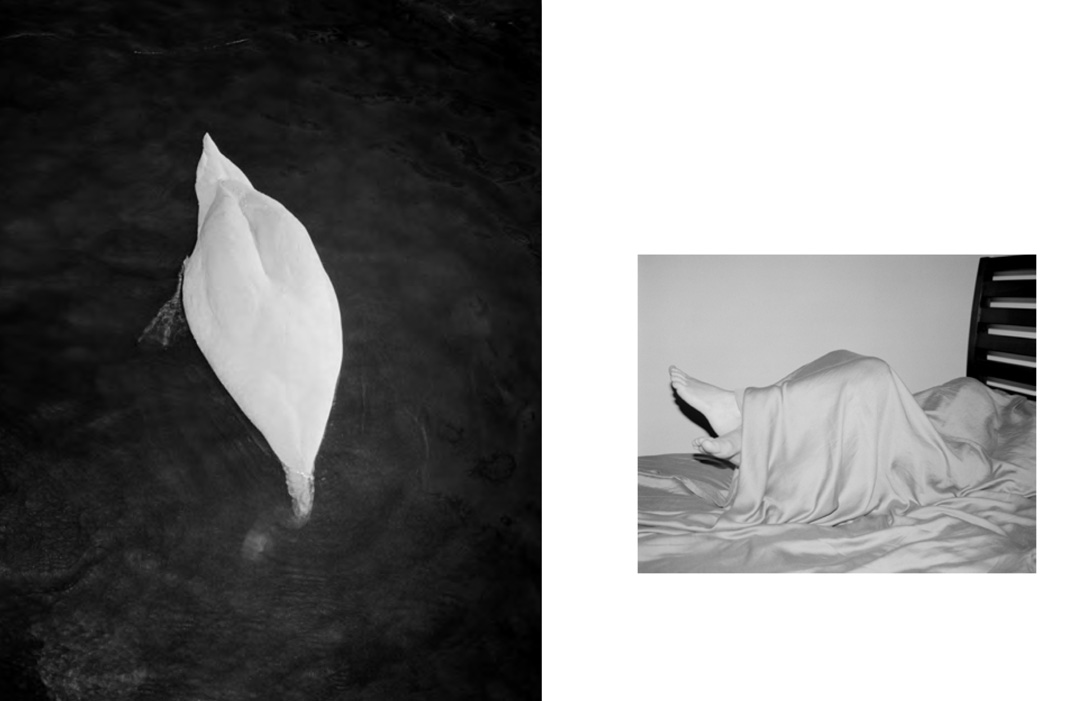

As well, Eich attempts to enhance through his photography by photographing his closest loved ones in their most intriguing forms, but as well, he photographs then in their most rawest beings to show life’s actuality and although it is an enhancement of family life in some way as it presented in a frame to look very aesthetically pleasing, the subjects are documented very informally yet poetically. Eich uses all his family and the relationship he has with these family members in his imagery to create a narrative but also uses environments as a way to respond to family life. I will be doing this throughout my own project where I photograph my closet to me to show, from the centralised view of myself, the relationship I have and how they may look and differ to that of my parents when they were younger and believed they would be with each other an eternity. I will be using, like Eich, metaphors of reality through, what many seem like an irrelevant image at face value.

Eich says that he wishes to show the fragility of memory but how it is paramount for collectives, as a unity to “wrestle these into a permanent state” in order for you as the collective to understand your place in this world because, according to Eich, it is “tenuous” This can insinuate that the world being very fast-moving and with its ability to be hurtful in its unfiltered system, families need to work together to create a safe and comfortable to place to remain in order acknowledge your important presence as this state you may find yourself in is very fragile and can be easily broken. I can connect with this statement very well and believe it will resonate in my own work.
Yoshikatsu Fujii - 'Red String'
(website)
“I received a text message. “Today, our divorce was finalized.” The message from my mother was written simply, even though she usually sends me messages with many pictures and symbols.
I remember that I didn’t feel any particular emotion, except that the time had come.
Because my parents continued to live apart in the same house for a long time, their relationship gently came to an end over the years. It was no wonder that a draft blowing between the two could completely break the family at any time.
In Japan, legend has it that a man and woman who are predestined to meet have been tied at the little finger by an invisible red string since the time they were born.
Unfortunately, the red string tying my parents undone, broke, or perhaps was never even tied to begin with. But if the two had never met, I would never have been born into this world. If anything, you might say that there is an unbreakable red string of fate between parent and child.”
– Yoshikatsu Fujii
My observations into Yoshikatsu Fujii’s work will help me carry out a more accurate and detailed, as well as cohesive and creative study into my parents divorce as a starting point for my project. I camera cross this artists when I became set on using the divorce of parents when I was younger as a starting point to allow me generate more ideas in terms of relationships within my life. The book that Fujii has produced looking at the life his parents once lead in comparison to now is amazing and I took an instant attraction to its form because of the handmade nature of it – because it was handmade with such care, it is much more original and authentic. The pages are much more than just paper with digital photos printed don them. Within the book, there are manually glued images onto old photo paper as well the use of red tape and red string to hold other aspects of what was inside the book together – this also has a relation to the meaning of the title – Red String – being this notion that a man and a women from birth are predestined to meet some day down the line of their life and an invisible red string would tie them together for an eternity.
In his project looking at a very uneasy subject to cover, Fujii uses both black and white imagery as well colour and photo montage as shown below. The most-part of his book is made of archival imagery taken from when his mother and father were together and from times when they would go out on day outs as a whole including Fujii as a child. He has centered the project around himself so that all products link back to him and how it has affected him but also telling a story about both of his parents and the different experiences he may have had with them separately – something I would like to present in my study – due to the break up being when I much younger – at 4 years of age – I have grown up, for 13 years with my parents being part from each other from the 4 years they were together when I was in the family also, I only remember every little details of this time and the majority of my upbringing has been nurtured form two different perspectives – when I was with my um during the week, I would follow her house rules and do activities with her and when I was at my dad’s on a Wednesday evening and a Saturday night/Sunday morning, I would have a different experience with him and do other activities, such as playing footie at the park with him. It is important for me to reminisce on these two different experiences.

Fujii captures still image of several documents culture together scattered across a table – these could perhaps be the divorce papers or papers from the process of the divorce occurring.
He also uses archival imagery from old photo albums to show a true representation of what their tight-knit community used to look like when together as a family. It shows them having fun and enjoying houselife but perhaps behind this, a deeper meaning lurks – in the two images below we see Fujii and his two other siblings as well as his mother and father in the frame on both occasions. Each fmaily member expresses the fun they are having through smiling or pulling funny faces for the camera but in the background of each image, the dad lurks, often unaware of the camera – he looks quite dislocated form the family as he stands behind, awkwardly resting on the chair as if he doesn’t want to be there. As well, he is the only one who does not smile in either of the photographs. Could this have been the time where moments in the house were at their worst but everyone else tried to disguise this through laughter?



In this fragmented picture of both Fujji’s mother and father on what seems to be their wedding day, he has contrasted this image with another, more modern and current image of his mother on the beach and it used to complete the image. Something interesting about the image is that the photo of them both dressed up was taken in a studio by the looks of things and this was a common method and a style of wedding portraiture in the nineteenth century – where couples would go to a professional portrait studio to be photographed before their wedding in order to document the marriage. In the current day, wedding imagery has become much more informal and encapsulates moments in time achieved through candid images due to the more advanced camera technology.
Alec Soth - 'Looking For Love'
(website)
“Love makes people do strange things. The history of mankind is rife with love producing illogical and oddball behavior. When it comes to photography, falling in love with the medium is hardly an exception. For example, someone painfully shy might find themselves impulsively photographing strangers without asking for permission. Or, they instinctively photograph something without any ability to later explain why. Alec Soth’s newest book Looking for Love, 1996 is, in its way, about both—the search for love guided by the heart and the search of love guided by the eye.”
– Time Magazine on ‘Looking For Love’
Alec Soth’s work has had a huge influence on other like-minded artists in the industry due to it’s ability to speak out about real-life events in such detail a depict both people and environments in their most true form – again, his style of work is very elegant and poetical – a theme and approach I am focusing on heavily in my selection of artists to take inspiration from as I wish for my own project to look like a visual poem which represent a journey through my life.
In particular, I will be looking briefly at Alec Soth’s project ‘Looking For Love’ whilst focusing my thoughts more so on similar artist like Matt Eich.
Soth, a Minnesota native, came to national attention in 2004 after his project Sleeping by the Mississippi was featured at the Whitney museum during its Biennial exhibition and consequently released in book form by the prestigious German publisher Steidl to critical acclaim. ‘Looking for Love’ was released in 1996 and he writes of imagining one day “a stranger would fall in love with me.”
The first photographs of couples we encounter in ‘Looking for Love’ cling possessively to their partners and gaze intensely at Soth’s camera as if to ask, “this is mine, where is yours?”. This photographic exploration reveals to us in hi journey, the outside landscape and various social gatherings—a particular bar; a convention hall that seems to bridge religion, spirituality and dating under one roof; poker games; singles parties; high school proms – all in which, we discover an element of love and attachment whether that be romantically and verging erotic as we see an image in which a high-school cheerleader leans in for a kiss with another of her same gender or whether this be on the basis of friendship as we see various shots in bars and clubs in which two characters are sat side by side, without interaction, yet still possessing some element of the ‘search for love’. We as the audience encounter moments of joy and laughter – that whether young or old, the ability to enjoy yourself and “let-go” and be free is still possible and all it takes is ‘love’ – it is a strong yet odd being and rules many lives. Love has the ability to pull people together as a community yet distance people from the ones they love the most. It is complicated but most importantly, the participants within feeling loved are happy because the intimacy and knowledge of having love surrounding you can define a person’s mood and life which in its own rights can be a positive thing as well as a negative thing.


Images like the above are what I wish to take inspiration from for my project looking at my relationship with my girlfriend. In these intimate and personal photographs I will be including myself. I hope to show the pure rawness of a relationship by being direct in how an image is composed – whether that be an image of us both sat on the bed looking int camera or an mage of us hugging intensely as the camera documents this. Images like these will be staged and will most likely be in black and white but then I also hope to create images that are more documentary style where I am capturing a moment in time of both of us being natural and these may be in colour and most likely taken on a 35mm film camera.

Soth has attempted to capture the aspect of being in groups or in two’s and this very much reiterates the idea of a community being a strong cohesive form. He captures groups of friends in their moments of obliviousness where they do not acknowledge the camera is documenting them and this makes for a “fly-on-the-wall” affect where the audience feel as though they are getting an insight into the lives of people in love – as though they shouldn’t be because it is such a personal thing that is best experienced within the participants. Myself and Lucy do show public affection but not often and limit this to hugging/holding hands/kissing on the cheek etc. and so I will attempt to show the more intimate and playful relationship we lead at home in a more natural environment where feel comfortable so the true representation of our relationship is presented. I will attempt to present a contrast of mine and Lucy’s playful and fun-filled, quite childish relationship against that of my mum and dad’s divorce but there will also be elements of similarities because I have come across old images of my mum and dad together in my dad’s room where they are on the bed taking photos of one another with my dad’s surfing poster’s in the background on his walls. However, because a relationship is meant to to be a quite secretive and internal thing within the participants, this is when the subjects involved feel most comfortable when they are with juts their partner where they feel they can open up about anything and can talk about anything – to just be themselves – and this is how both Lucy and I feel and at moments, we may both feel vulnerable in the relationship we are in because we put our trust in their being. There is definitely a sense of feeling fragile and sensitive at times and this will be important to also show – which is why I want to include myself in the images to present this sense of fragility and vulnerability – especially in myself because I know that I am a sensitive person and can get easily upset and annoyed – something that I can admit and men tend to wish to not say or reveal about themselves bit feel comfortable doing this in my relationship so feel it important to show it.

LaToya Ruby Frazier - 'The Notion Of Family'
(website)
“The Notion of Family, offers an incisive exploration of the legacy of racism and economic decline in America’s small towns, as embodied by her hometown of Braddock, Pennsylvania. The work also considers the impact of that decline on the community and on her family, creating a statement both personal and truly political— an intervention in the histories and narratives of the region. Frazier has compellingly set her story of three generations—her Grandma Ruby, her mother, and herself”
– Aperture on ‘The Notion Of Family’
LaToya Ruby Frazier exploration into the town she lives in and its culture and the people within this tight-knit community, especially her family, is a project that is very powerful and addressees a range of issues for the audience to get a very incisive insight into the community of Braddock and America’s legacy of racism and the decline in economy.
Out of all my other chosen artists, I would say that Frazier’s work is the most well composed as a whole – it is the most powerful due to the subject matter and this is aided by how Frazier has the ability to construct an image so thoughtfully and artistically to produce a product that has had such an impact on the people of the location focused on in the series.
The image below frames both Frazier as a teenager in 2008 with her mother. It shows her mother from a side profile and Frazier in the background, yet in focus. Behind her mother as they are both sat on the edge of a bed, Frazier looks deeply at her mum’s face as the mother looks down at the floor. It is an image which can be interpreted in so many different ways – a wonderful aspect of this project, however, most images provide a direct explanation for the audience to unpick. The image below, however, is more difficult to decode because we do not know the context of the image and we are not aware of the relationship between Frazier and her mother – whether it is stable or hampered by the racist merry-go-round which makes it way round the town they live in, haunting the people of black origins. The emotion shown below is very serious and we can get a sense that something does not sit well within this household.
It is as though Frazier is gazing deeply at her mother to attempt to get her attention, however, her mother, the older, more prominent figure in the household fails to acknowledged this cry for possible help that Frazier is calling for in both of the times of need. They both seem very vulnerable and this is displayed both in their body posture and facial expressions – slouched and a blank face – as though there is an empty space within their relationship.
The way the image is composed, like I mentioned before is what makes this photograph so strong because there is clear thought that has gone into composing and framing the image. Frazier’s face, which we only see half of, completes the other half of her mother’s face – the side profile of he mother’s face presents her as more powerful however, yet the ability to see, front-on, Frazier’s facial expressions allows us to understand her silent cry for help as she looks deeply at her mother but fails to catch the attention of her.

Another aspect of Frazier’s work is that it is captured mostly within her household to show the breakdown of her family from the inside. The house may be where the abuse and discomfort within their community originates from because this is where their family are held together and the home could be metaphorically shown as a place of unrest – where you are trapped and can’t escape, particularly in Frazier’s case.
The image below is also another of Frazier’s strongest images as it shows a clear division between herself and what looks like her other’s new partner, as I believe Frazier lacks father figure in her life and her other has in fact moved on begun new life with a new man – of which Frazier did not approve of. This is shown quite clearly how the image below is composed. On the left we see this masculine figure lying on the bed in his room, and on the right is Frazier, sat rather awkwardly on the edge of bed, again, slouched and in her lounger. The two are divided by a wall which separates their two rooms and the doors that are both open is what frames the two sides. The dislike Frazier shows for this man is shown clearly, again in her posture. She has her back to the man and he as well has his back to her. I would imagine that Frazier found her step-dad lying lie this coincidentally and decided she would frame herself in the image also to show her dislike for him.
The man is also wearing a vest which reads “THE SMOOTH EDGE” on the back and we get a sense that this may be an oxymoron or rather ironic because he most likely does not act like what we would envisage “the smooth edge” to. He seems as though he may the division between Frazier ad his mother; in that he causes a certain friction within the house that presents him more so as a “rough edge” – not the intermediary figure of the house. This is quite ironic but then again, this juts me making assumptions and decoding the image how I see fit.
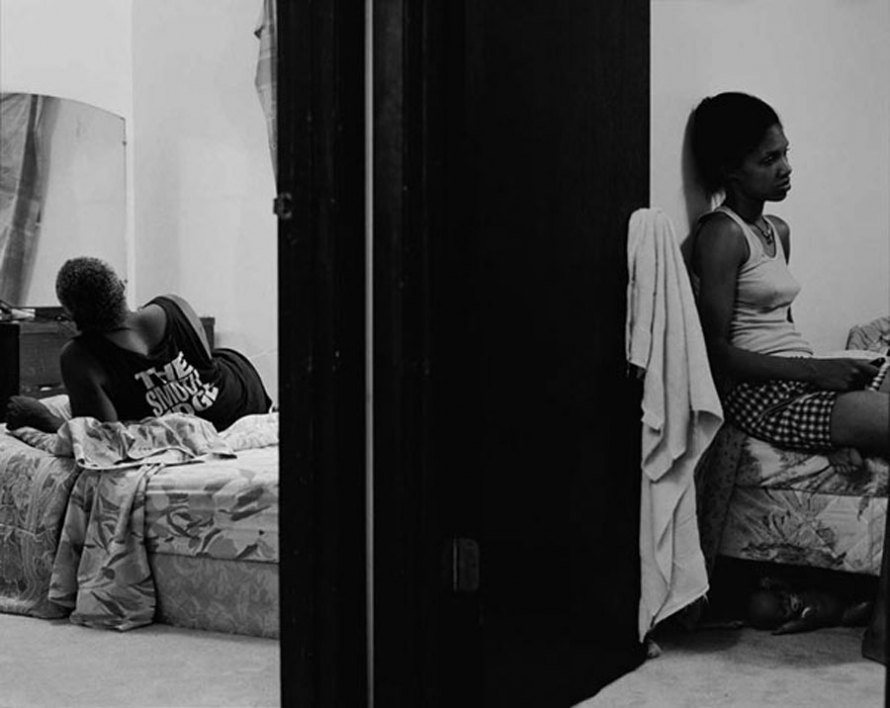

Frazier, as well as Fujii, uses passages of text in her photo-book to accompany her images and the images shown above is accompanied by a poem written by Frazier. The concept of using short passages of text, even a sentence, constructed by myself attempting to express what is shown visually or taken from a statement made by one of subjects of the book, is something I would really like to incorporate into my photo-book because it adds another function to the book and adds another aspect of depth and character to enhance the impact the book can have. Fujii uses short sentences transcribed from messages his mum and dad sent when their divorce was finalized and the impact is very powerful because it allows the audience to relate and engage themselves within the concept more.
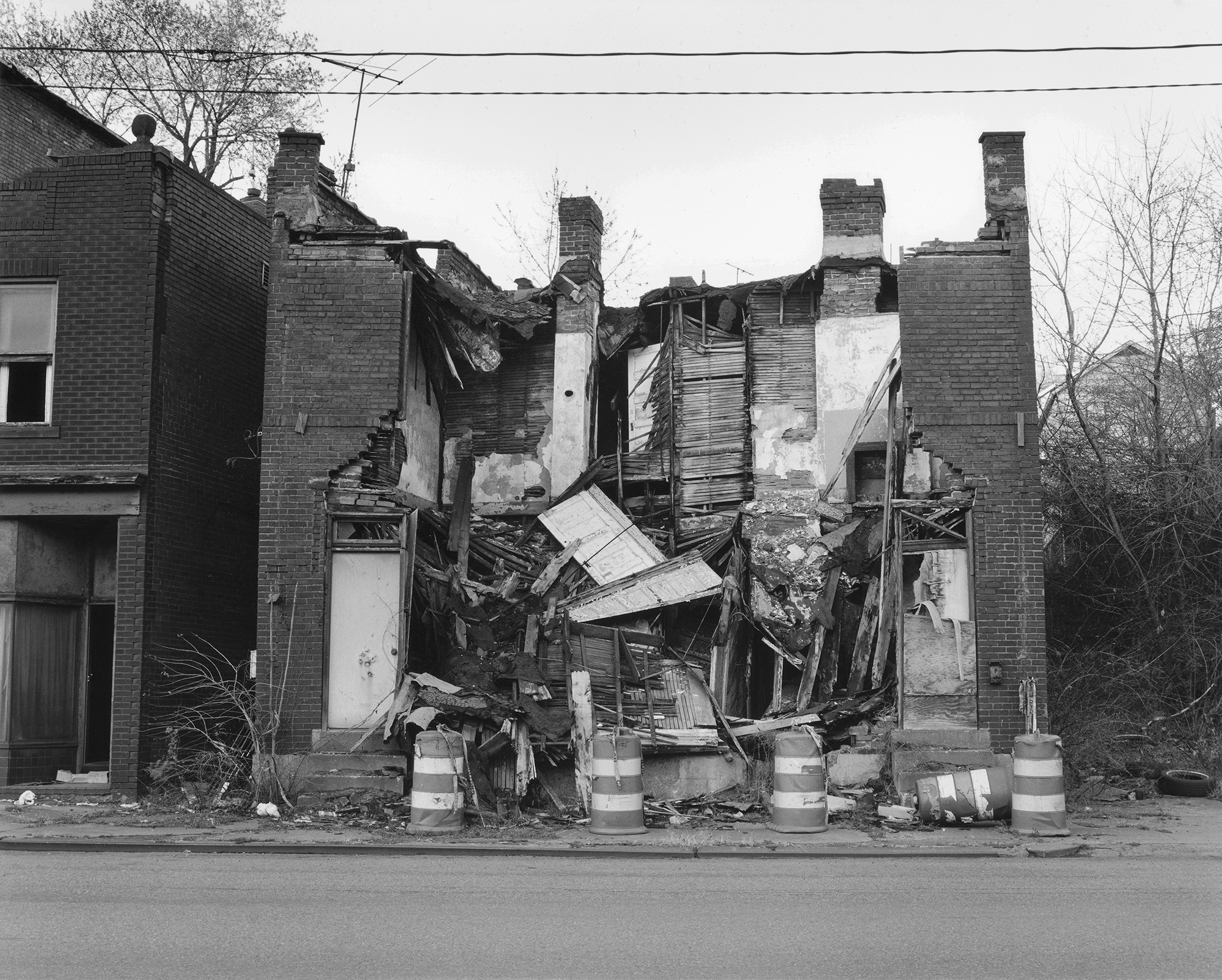
Arno Brignon - 'Josephine'
(website)
“July 1, 2009, birth of Josephine. Doubt and fear mingle with joy and pride. Having a child can be the simplest thing in the world. For us it was long, improbable, unique. At the maternity ward, they call it a “precious pregnancy.” It is also an announced imbalance to our life as a couple, a love story to two to rebuild three.
Josephine is 6 years old today and doubts have dissipated. Love is obvious. The fear of death is another. I live with both. The family cocoon crumbles with entry to school. I take back the device. I photograph Josephine, in a fight that seems lost in advance, so that it does not escape too quickly, so that the sweet and loving fusion of this microcosm of three continues. I found my place. Time passes and I can finally say that nothing is opposed to the night, nothing justifies … and I have everything to dare.”
– Arno Brignon
Arno Brignon is a French photographer and in her series ‘Josephine’ she looks at the fragility of the family cocoon and how this can be broke by the introduction of a newborn – your child. In Brignon’s case, this was very abrupt and she did not know how to deal with it and the responsibility that weighed ion her shoulders. Therefore, she began to documentary this transformation and adaption she has had to make and the result is a very warm and vibrant, yet dark and meaningful series of works that encapsulates her child – Josephine and how she has become the center point of her life. Brignon is the artist I will taking inspiration from for the point at which I begin o collaborate with my 4 year old sister to produce work for my project looking at my relationship with her, which over the last year, has become more complicated and upsetting for myself as I now no longer see her very much due to the split of my dad and his partner (Minnie’s mother) who will not be included in the project because I do not feel the need.
Brignon’s differ form the other artist work also shown in this post in that they much more vibrant in their colour yet feature much more darkness from the contrasts of shadows. It looks like they have been taken using a 35/50 mm film camera due to the clear grain which you can see in the images as well as the quite washed out and hazed colours which are provided with film.
The image below is from the series of 45 images produced by Brignon, and, in my opinion is one of the best because it is a very meaningful. It shows two horses back-back-back grazing on the ground of the field they are seen in which is in the background of the image. The foreground consist of a well-kept prim and proper garden filled with greenery and bushes and features vibrant colours. As you move your yes further through the mage towards the back, you come across much more neutral, less vibrant colours of dull and washed out pinks and beiges as well as greys – it is almost like a dusky pink and the two colours from the image look like they are from images taken at two different times. In the centre of the image, well placed in between two bushes are two horses stood back bac to back grazing at the grass of the field. The two animals are the obvious focal pint of the image and have been used by Brignon, presumably to represent a metaphorical representation of her other half in her family – her boyfriend/husband. From the birth of their child, an event and milestone in a couples life that should provide happiness for an eternity, may have broken the couple apart and it could have tested their relationship to their breaking points, which, as well, it what a birth of a child can do to a relationship which was once stable. The introduction of a child requires each parents to give up son much of what they once had in order tot look after this new responsibility and to can sometimes be too much for them both to take – forcing the break u if their relationship and the separation of the family. I have experienced this when I was younger when my parents decided to split and so has my sister unfortunately at the same age as when it happened to me. It is sometimes inevitable and although this may not have happened in Brignon’s case, these two horses may represent the gradual distancing they have experienced with one another through trying to juggle work and home life. Although they are to an extent, separated emotionally and may encounter more stress and friction, they still love each other and this often the case with most break-ups – although the split as occurred, both halves still stay strong for the child’s sake but this image can represent the hardship a family can got through when dedicating so much of you time to care for your newborn

Images like the one below could be seen as happy accident because Brignon may have not intended for the blur to be a part of the image and perhaps was desperately attempting to get each feature of the image in focus and crisp as possible and the blur may have been accidental but the outcome has turned out to be very successful and effective and perhaps Brignon took a liking to it an chose to use it in her project. The image shows Josephine kissing another girl who looks to be her age – maybe a school friend as she looks into the camera which is a very nice touch as it shows the sense of naughtiness of childhood din that sometimes they may be doing something they’re not supposed to and often look to the aren’t for a say so as to whether it is okay or not. There is something quite cheeky about the image and this is what I love, yet the soft focus make sit seem quite dreamy and heavenly, much like the other images sin the series like the one below. The common theme and atmosphere is dreaminess and a haze as children often get caught up in the fun of things that they forget what is going on but as well, due to the dark contrasts and shadows of the imagery, there is also a quite sinister and eerie sense to the series – as if something does not seem right and this in-turn makes the viewer feel quite on-edge.
Brignon photographs the very intimate moments that she finds in and around her family and home life on a day-today basis and she also includes herself with her daughter within the images. There is sense of intimacy and connection between the mother and daughter bit there is little evidence of the father within the project and it is shown as though the mother and daughter have formed a close bond and the dad is a lost identity within the system. Images of Brignon with Josephine in the bath and the two of them present in the image together is what shows the sense of family and love and connection in times of hardship – where you have to keep striding on.


Rita Puig-Serra Costa - 'Where Mimosa Bloom'
(website)
“Dealing with the grief that the photographer suffered following the death of her mother, Where Mimosa Bloom by Rita Puig Serra Costa takes the form of an extended farewell letter; with photography skillfully used to present a visual eulogy or panegyric. This grief memoir about the loss of her mother is part meditative photo essay, part family biography and part personal message to her mother. These elements combine to form a fascinating and intriguing discourse on love, loss and sorrow.”
– Editions Du Lic on ‘Where Mimosa Bloom’
This particular artist is whom I originally got my inspiration from to produce the shoot I completed which resulted in my series looking at childhood memories of my family members. This was one of the best series I have created during my time as an amateur photographer because of the poetical nature of it and the narrative it told of how one moment in time can have an affect on our futures and how we lead out lives butt his one recollection of a past time can often be forgotten about, however, the memory still has meaning and substance to generate an emotion from the subject it is linked with.
Rita Puig-Serra Costa, in her series ‘Where Mimosa Bloom’, uses archival imagery and objects from her family archive to create a story and emphasise the essence of past times in order to tell a story of her dead mother and the life she lead and the impact she had on people around her. Using archives from each person my ‘Childhood Memories’ series was also essential allowed me to tell a ore poetical story because I was showing the physical object which had such meaning to the owner of it.
I would love to again use archival imagery from my own archive as well as delving into my family members archive to find some interesting memoirs hat can be the driving force of my project to send it in a direction which would make for an interesting story. I have already begun to look into the archive of my dad to discover memories he has kept of his time with my mum and this has already opened up my eyes to what their life was like when they were together, nurturing me and caring for me with all their love – as a cohesive family and intend to use these discoveries in my project.
However, a concept I would like to explore in my project is the creation of family tree – in the style that Rita Puig Serra Costa presented in her book. One page after another, as you turned through the beginning of the book, a new family embers portrait was revealed – what looked like a passport photo or a photo taken in a photo booth. This reveled a careful and thoughtful set up of a sequence of portraits next to, and underneath each other as each page was turned. On the last page of the sequence, the last family member was revealed and it resulted in a very effective family tree set-up (show below) – something I would be interested in producing for my own project as this would show the relationship which have been grown and then, sometimes, broken off in my own family and would set up the story to come.

The image below is from a segment of the book which looks at the concept of paring a still-life object-image with a portrait to show the relationship between the person and the object. This is what I adapted in my own series to suit that of my own family members and and tell a story of their own reminiscences from when they were younger.
I will be using the same concept of photographing a meaningful object in the story of the relationship of my mum dad against a black background as this is the only way of researching into their relationship and from this research I will conduct, it will allow me understand what their life, as well as mine was like when I was younger and oblivious to everything around me. From this, I can also conduct small interviews with my parents to understand the best and worst memories from when I was a child – I will also ask myself this.
